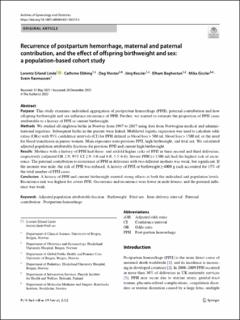| dc.contributor.author | Linde, Lorentz Erland | |
| dc.contributor.author | Ebbing, Cathrine | |
| dc.contributor.author | Moster, Dag | |
| dc.contributor.author | Kessler, Jørg | |
| dc.contributor.author | Baghestan, Elham | |
| dc.contributor.author | Gissler, Mika | |
| dc.contributor.author | Rasmussen, Svein | |
| dc.date.accessioned | 2022-08-17T09:42:55Z | |
| dc.date.available | 2022-08-17T09:42:55Z | |
| dc.date.created | 2022-05-10T12:38:04Z | |
| dc.date.issued | 2022 | |
| dc.identifier.issn | 0932-0067 | |
| dc.identifier.uri | https://hdl.handle.net/11250/3012300 | |
| dc.description.abstract | Purpose: This study examines individual aggregation of postpartum hemorrhage (PPH), paternal contribution and how offspring birthweight and sex influence recurrence of PPH. Further, we wanted to estimate the proportion of PPH cases attributable to a history of PPH or current birthweight.
Methods: We studied all singleton births in Norway from 1967 to 2017 using data from Norwegian medical and administrational registries. Subsequent births in the parents were linked. Multilevel logistic regression was used to calculate odds ratios (ORs) with 95% confidence intervals (CI) for PPH defined as blood loss > 500 ml, blood loss > 1500 ml, or the need for blood transfusion in parous women. Main exposures were previous PPH, high birthweight, and fetal sex. We calculated adjusted population attributable fractions for previous PPH and current high birthweight.
Results: Mothers with a history of PPH had three- and sixfold higher risks of PPH in their second and third deliveries, respectively (adjusted OR 2.9; 95% CI 2.9–3.0 and 6.0; 5.5–6.6). Severe PPH (> 1500 ml) had the highest risk of recurrence. The paternal contribution to recurrence of PPH in deliveries with two different mothers was weak, but significant. If the neonate was male, the risk of PPH was reduced. A history of PPH or birthweight ≥ 4000 g each accounted for 15% of the total number of PPH cases.
Conclusion: A history of PPH and current birthweight exerted strong effects at both the individual and population levels. Recurrence risk was highest for severe PPH. Occurrence and recurrence were lower in male fetuses, and the paternal influence was weak. | en_US |
| dc.language.iso | eng | en_US |
| dc.publisher | Springer | en_US |
| dc.rights | Navngivelse 4.0 Internasjonal | * |
| dc.rights.uri | http://creativecommons.org/licenses/by/4.0/deed.no | * |
| dc.title | Recurrence of postpartum hemorrhage, maternal and paternal contribution, and the effect of offspring birthweight and sex: a population-based cohort study | en_US |
| dc.type | Journal article | en_US |
| dc.type | Peer reviewed | en_US |
| dc.description.version | publishedVersion | en_US |
| dc.rights.holder | Copyright 2022 the authors | en_US |
| cristin.ispublished | true | |
| cristin.fulltext | original | |
| cristin.qualitycode | 1 | |
| dc.identifier.doi | 10.1007/s00404-021-06374-3 | |
| dc.identifier.cristin | 2023074 | |
| dc.source.journal | Archives of Gynecology and Obstetrics | en_US |
| dc.identifier.citation | Archives of Gynecology and Obstetrics. 2022. | en_US |

